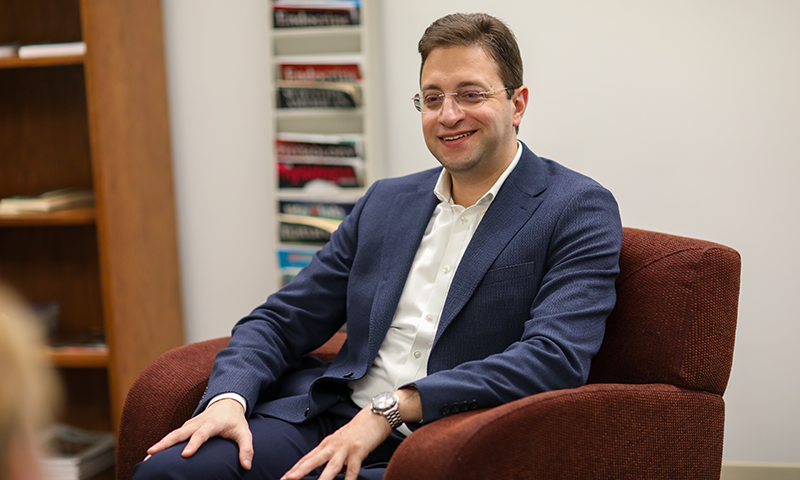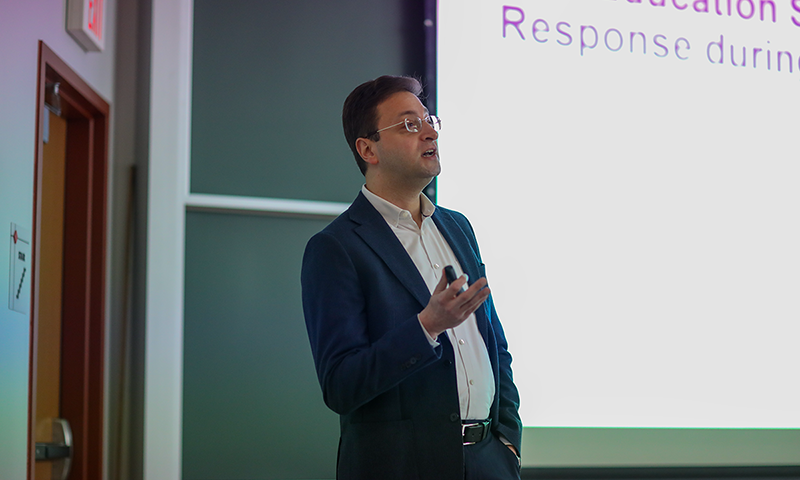The Wabash Global Health Initiative hosted Dr. Wassim Labaki ’08 for a campus-wide presentation, multiple classroom visits, and one-on-one conversations with pre-health students. He is a critical care pulmonologist who served on the front lines of the COVID-19 pandemic, treating some of the sickest patients.
 After graduating in 2008, he was drawn to Georgetown University School of Medicine by its philosophy of Cura personalis, care for the whole person. As a medical student, he provided compassionate care to underserved patients through the Hoya Clinic, a student-run, faculty-supervised free clinic in Washington, D.C.
After graduating in 2008, he was drawn to Georgetown University School of Medicine by its philosophy of Cura personalis, care for the whole person. As a medical student, he provided compassionate care to underserved patients through the Hoya Clinic, a student-run, faculty-supervised free clinic in Washington, D.C.
He went on to complete his residency at Johns Hopkins University, which he called “my foundational education in clinical and internal medicine.”
Labaki later returned to the Midwest for a pulmonary and critical care fellowship at the University of Michigan, where he also earned a master’s degree in clinical research design and statistical analysis. He joined Michigan’s faculty as a clinical lecturer in 2018 and was promoted to assistant professor in 2020.
That same year, everything changed.
“In late January, the first COVID-19 case in the U.S. was identified in Seattle,” Labaki said. “You can imagine, this kind of story definitely catches your attention as a pulmonologist and a critical care specialist. But we didn't know what to make of it then.”
At University Hospital in Ann Arbor, Labaki and his team monitored the progression of the virus closely. The hospital prepared its Regional Infection Containment Unit (RICU), a pressurized, ventilated area designed for such outbreaks. Soon all 64 beds were filled with patients in acute respiratory failure. Overflow patients filled intensive care units (ICU) across the hospital until every bed was occupied.
"We were opening new intensive care units, which were not ICUs in the first place—on this floor, that floor, even the post operative room,” Labaki said. “It escalated really quickly.”
There were conversations with the military, and plans were made to convert a nearby dorm into a field hospital. "One of my radiology friends called me and said, ‘I haven’t held a stethoscope in years, but I might be assigned to the field hospital. Can give you some tips?’ We were that close,” said Labaki. “Thankfully, we did not get there.”
Despite years of training and clinical experience, everything felt unfamiliar. Practitioners communicated through glass with walkie-talkies. Families said goodbye through screens. Rounds that once ran with precision stretched into chaos as staff cared for overwhelming numbers of critically ill patients.

“As you can see, from the telemetry, the blood work, the chest imaging, and the ventilator, it was continuous data coming at you,” Labaki said as he pointed out a cluster of machines in a photograph taken in the RICU in 2020. “But remember, it wasn’t just one patient and they were all very complex.”
The work was physically and emotionally exhausting. One crucial therapy for severe respiratory failure—proning, or turning patients onto their stomachs for 16-18 hours a day—required five or six people per patient to navigate the tangle of tubes and machines.
Many patients depended on multiple forms of life support, attached to many machines through a collection of tubes, drips, and wires. They relied on a mix of blood products, vasopressors, fluids, antibiotics, and continuous renal replacement therapy, a form of 24-hour dialysis.
While the rest of the world sheltered, medical staff risked everything to treat the sickest patients.
“I'm very proud that we knew we were the front lines and we went after it. Whatever it cost, we were going to do it. This was part of our mission. But nonetheless, these were very uncertain, very difficult times.”
Through the darkest times, Labaki’s team found hope in patient success stories and full recoveries.
“Despite the pain and death, we did save many, many lives,” he said. “That, along with community support, kept us going.”
It was often the little things that made a big difference. Labaki remembers the sores and bleeding behind his ears from wearing an N95 mask twelve or more hours a day.
“Someone in the community with a 3D printer created clips that held the N95 straps and kept them off our ears,” he said. “It might seem small, but it changed my life.”
University Hospital has returned to normal and makeshift ICUs reverted to the wards they were in 2019. Today, the ICU is a small part of Labaki’s work. He wears many hats across clinical care, research, education, clinical trials, and administrative responsibilities.
“I like what I do,” he said. “I find it fascinating, but it requires a certain skill set, a well-rounded education, to be able to handle all these tasks, lead different teams, think on your feet, and also plan long-term for grants and clinical trials.”
Labaki urged students to seize their liberal arts education, referencing the words of chemist Louis Pasteur: “Chance favors the prepared mind.” He encouraged them to develop their writing skills and embrace all their courses “like life depends on it.” The content of the classes is important, but the process it what really matters.
He still recalled lessons from Econ 101. “I almost never used the concept of optimization or of marginal benefit and marginal cost later in life from an economic standpoint, but I do use it every time I have to make a quick decision in the ICU,” he said. “I want to optimize treatment and make sure I end up with the largest benefit possible when given options.
“Wabash set me up for a life of continuous learning, curiosity, and intellectual humility," said Labaki. “What attracted me as a 17-year-old student, 8,000 miles away and gleaning what he could from the College website, was the mission: think critically, act responsibly, lead effectively, and live humanely.
“Looking back now, this is what matters in all parts of my job. And during the pandemic, that guided everything we did.”